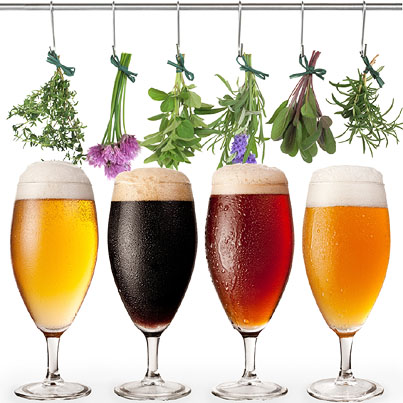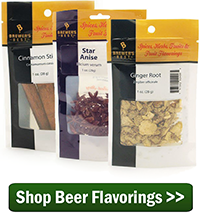 Brewing beer with herbs is not some new fad, a product of the recent craft beer boom. Before hops were popular (we’re talking hundreds of years ago), a wide variety of herbs and spices provided the bittering and flavoring characteristics to balance beer’s malty sweetness. Brewing beer with herbs was the norm. By adding herbs in your own homebrew, you can recreate ancient styles of beer (such as Sahti and Scottish Gruit) and also exercise your creative spirit to develop something entirely new. Below are just a short list of herbs, flowers, and other plants that can be used, alone or in combination, to contribute a unique flavor profile to your homebrew:
Brewing beer with herbs is not some new fad, a product of the recent craft beer boom. Before hops were popular (we’re talking hundreds of years ago), a wide variety of herbs and spices provided the bittering and flavoring characteristics to balance beer’s malty sweetness. Brewing beer with herbs was the norm. By adding herbs in your own homebrew, you can recreate ancient styles of beer (such as Sahti and Scottish Gruit) and also exercise your creative spirit to develop something entirely new. Below are just a short list of herbs, flowers, and other plants that can be used, alone or in combination, to contribute a unique flavor profile to your homebrew:
|
|
|
When thinking about how to use herbs in homemade beer, add them in the same way as we do hops. These herbs may be added early or late in boil (depending on whether you’re looking for more bitterness, flavor, or aroma) or to the secondary fermenter, just like with dry hopping. One thing to keep in mind when brewing beer with herbs is that the herbs tend to be more delicate than hops. Many of them don’t need to be boiled as long as hops in order to extract bitterness and flavor.
You can pick these herbs from your own garden, or buy them from the store. Many herbs are available as tea blends, the tea bags making it east and convenient to strain out the herbs.
When developing an herb beer recipe, think about what flavor characteristics work well with the base beer. The herbs should complement the style characteristics, rather then dominate them. (Consult the BJCP guidelines for style 21A for more detailed information.) If brewing a gruit, forgo the hops. Other base beer styles, such as pale ale and wit, can be given an interesting twist by incorporating herbs in addition to the hops.
To help start you out brewing beer with herbs, here is a pale ale recipe using oregano. Feel free to substitute basil, rosemary, and other herbs as desired.
Oregano Pale Ale Recipe (5 gal):
OG: 1.054
FG: 1.011
ABV: 5.6%
SRM: 11
All-grain:
8 lbs. Two Row Malt
1 lb. Munich Malt
1 lb. Caramel 40L
Partial Mash:
6 lbs. Golden Light Extract
1 lb. Munich Malt
1 lb. Caramel 40L
Hops:
1 oz. Northern Brewer @ :60
1 oz. Centennial @ :30
0.5 oz. Tettnanger @:15
0.5 oz Tettnanger @ :5
Other:
0.25-1 oz. of fresh oregano* @ :15
1 tsp. Irish Moss @ :15
Yeast:
Wyeast 1056 American Ale Yeast**
*The oregano can contribute a lot of bitterness and flavor. Up to a full ounce of fresh oregano may be used, but may need to be aged depending on your taste preferences.
**For best results, prepare a yeast starter.
Have you ever tried brewing beer with herbs before? How did it turn out? Do you have an herb beer recipe you’d like to share? Put it in the comments section below.
—–
David Ackley is a beer writer, brewer, and self-described “craft beer crusader.” He is a graduate of the Siebel Institute of Technology’s “Start Your Own Brewery” program and the Oskar Blues Brew School in Brevard, NC.

Hi! I’m a beginner and would like to add some lavender to a blonde ale, you think it’ll work? If I only want a bit of flavor and the aroma, how much and at what point should I add it?Thanks!
Andrea, if you want just a bit of flavor and aroma, I would add about half an ounce to the secondary fermentation. You might want to put the Lavender in a hop bag or something similar, that way you can closely monitor the flavor and remove it easily when you reach your desired flavor.
I wanted to brew a lilac beer, as there is a lot of the pretty things growing all over my neighborhood. After consulting various sources online I found out that it was imperative to only use the flower, as any other part of the plant gives a rather unpleasant vegetable-ish flavor. I decided I needed 100g of lilac flower (50g for a 24l batch), and then found out 100g is A LOT of lilac flowers. My wife and I spent two whole evenings separating enough tiny flowers from the rest of the plant. We are talking thousands of flowers.
The beer I decided to use as a base was a Belgian blonde, and – huge mistake – I ended up using a yeast strain I had never tried before – the T-58. I could never decide where all the banana and clove character ended and the lilac – whatever that ended up tasting like in my beer – began.
Several years later – even though I am now a more seasoned home brewer with a steady and dud-free production of beers of all kinds – I have never really felt like trying my luck with lilac again.
I really want to start brewing beers but i am very new in this field can someone give me idea please ?
Rajaram, I highly suggest you visit your local home brew shop and talk with them. They can get you set up and point you in the right direction. Happy Brewing!!